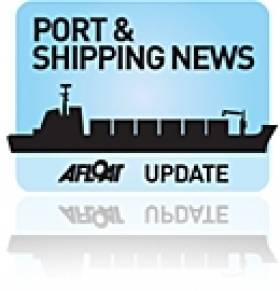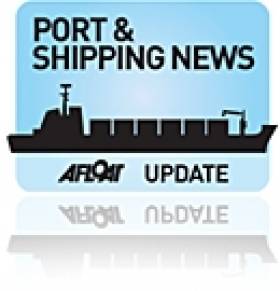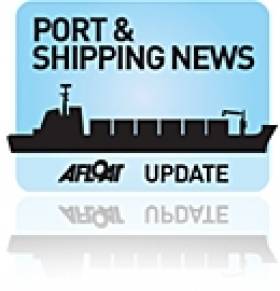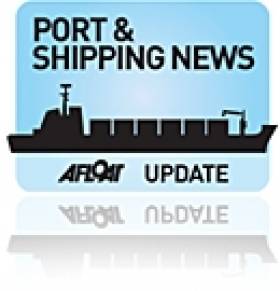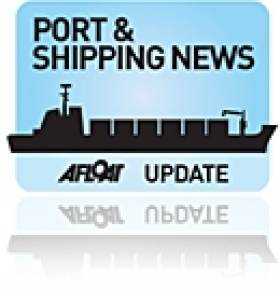Displaying items by tag: Ports and Shipping News
#Ports&ShippingReview: Over the last fortnight, Jehan Ashmore has reported on the shipping scene, where Warrenpoint Harbour call for funding to construct relief road to avoid traveling through Newry City.
The European Sea Ports Organisation (ESPO) recognised the Italian Presidency efforts at the Transport Council to reach an agreement on Port Regulation proposals.
Shannon Foynes Port Company announced record profits for 2013, the fourth successive year in such growth, showing a 3% increase in Operating Profit at €4.1m, up from €3.1m in 2012.
Government to back Galway Harbour's €52 million redevelopment of a first phase of a port expansion.
The IMDO release report Irish Tonnage Tax: Opportunities for the International Shipping Industry. The independent report by PwC details the benefits of the tax regime established in 2004 and the attractions of maritime operations locating in Ireland.
Dublin Graving Docks Ltd faces closure as Dublin Port Company plan a €200m Alexandra Basin Redevelpment Project that incorporates the site of the 200m long graving dock. Currently the dry-dock is occupied by Arklow Ranger and Jeanie Johnston.
Ports & Shipping Review: Major OPV Conference, Bantry Works 2016, First Irish Maritime Forum, NMCI 10th Anniversary and Samskip On Sulphur
#Ports&ShippingReview - Over the last fortnight, Jehan Ashmore has reported on the shipping scene, where The International Offshore Patrol Vessels Conference was held in Dublin, the three-day event was chaired by Rear Admiral Mark Mellett of the Naval Service.
Councillors at a Western Committee meeting held in Cork, were informed the start date for the redevelopment plans for Bantry Harbour costing up to €7m would not be until at least 2016.
Also in Cork city, more than 150 delegates from the maritime industry attended the inaugural Irish Maritime Forum hosted by the Port of Cork, in partnership with the Irish Ports Association (IPA).
It was then the turn of the IPA's counterpart in the UK, the British Ports Association (BPA) which held their annual conference yesterday which was hosted by Warrenpoint Harbour Authority in Newcastle, Co. Down.
The National Maritime College of Ireland (NMCI) celebrated its tenth anniversary. As a provider of world class maritime education and training, an event to mark the occasion was to be led yesterday by Minister for Marine & Defence, Simon Coveney, TD.
Samskip CEO, Diederick Blom has said the increasing cost of new low-sulphur fuel from the regulations 'may drive a shift back to road transport on certain European shortsea routes'.
#SamskipSulphur – Samskip CEO, Diederick Blom has said that new sulphur regulations will increase line's bunker bills by 50%, according to LloydsLoadingList.com
The CEO added the increasing costs of fuel resulting from new low-sulphur fuel regulations may drive a shift back to road transport on certain European shortsea routes.
Some operators had already closed services anticipating a modal shift in favour of road transport when new rules come into force in January, although he felt this would be a short-term development. "Longer term we expect transport by sea and rail will increase and by more than road," he said.
"The European white paper on transportation says that one third of road traffic that travels more than 300 km will have to be off the road by 2030 and in total 50% will need to be off the roads by 2050. So the European Commission will have to make road transport less efficient than it is today in an attempt to support transportation by sea and by rail."
Samskip is expecting its fuel costs to increase by 50% as a result of the new sulphur regulations that will force it to switch to more expensive marine gas oil.
Blom said that most of the carrier's shortsea operations are conducted in the Baltic Sea, North Sea, English Channel and North America.
These emission-control areas will be subject to a 0.1% sulphur limit from January 1, 2015, up from the current 1% limit. For more on the impact of sulphur regulations, click HERE.
In July of this year, Samskip Multimodal announced a new part-load service between Italy and Ireland.
IMDO Shipping Review: New Dublin Docklands Masterplan, Floating Harbour, Concerns Over EU Port Reform and Much More
#IMDOshippingreview –The latest IMDO Weekly Shipping Market Review includes the following stories as detailed below.
Irish Ports: New Master Plan for Dublin Docklands - The Master Plan is a very comprehensive document covering social regeneration, economic development, land use, transportation, infrastructure, urban design, arts, culture, tourism and leisure. It now has a more realistic approach to developing the docklands in a way that will ensure a balance between commercial and residential.
Global Ports: Floating Harbour Transhipper - A floating harbour transhipper (FHT) is similar to an offshore warehouse. The idea is that cargo is loaded onto the FHT directly at the point of production and brought out to the bigger ships rather than having them come in and docking in port. This idea has evolved from the lightering crane barge, which is already well established in some countries.
ECSA Concerns over EU Port Reform - In a press release earlier this week the European Community Ship Owners Association expressed concerns regarding the watering down of proposed Regulation to establish a framework on market access to port services and financial transparency of ports. Concerns are raised that Member States are contemplating excluding cargo handling and passenger services from the Regulation while the exclusion of pilotage remains uncertain.
For more on each of the above and other stories from the IMDO Weekly Markets Review (Week 39) click HERE. In addition to Afloat.ie's coverage of Ports & Shipping news.
Councillors Given 2016 Start Date for Bantry Harbour Redevelopment
#BantryHarbourPlans – According to the Southern Star newspaper, councillors during a recent western committee meeting in Cork, were given a date for the much-mooted ambitious plans for Bantry Harbour.
Plans for the multi-million euro re-development of the town's inner harbour were once more outlined to the members, including the detail that Phase One, which will cost up to €7m, will see the dredging of the inner harbour, improvements to the town pier, an amenity area, and the construction of pier side pontoons.
But the meeting heard that it could be almost two years – in 2016 – before the work gets underway.
Brendan Keating, CEO of the Port of Cork company, told councillors that the Phase One work was necessary to ensure that Bantry Bay will become a key regional port for the south west.
To read more of the plans, the newspaper has a report here.
Cork Dockyard Contract of Irish Lights Vessel Faced Stiff Competition from European Yards
#CorkDockyard – ILV Granuaile, the Commissioners of Irish Lights aids to navigation tender departed Cork Dockyard's graving dock today, following a major work contract won in the face of stiff competition from European yards, writes Jehan Ashmore.
The ILV Granuaile in the presence of local tugs made a lunchtime exodus of the graving dock. She then went alongside the layby berth of the 44-acre facility in Rusbrooke where 30 years ago the last ship built by the former Verolme Cork Dockyard was launched.
According to CIL, the contract won by Cork Dockyard Ltd (part of the Doyle Shipping Group) was secured from competing yards in the UK and France. The contract for a '15 year Special Survey and Drydocking' followed a competitive EU tender and is part of an overall €650,000 project to so to enable continued operation of the ship to Lloyds +100A1 Classification.
The yard's work was to carry out hull and superstructure painting, repair tasks and major tank surveys. As well to this overhauls to both Schottel and bow thrusters were required plus an inspection of the hull's plate thickness.
ILV Granuaile entered the 165.5m (539ft) by 22.5m (73ft) wide graving dock in late August, having engaged on an international charter working on wind farms in the German Bight and in waters off the Netherlands.
Prior to her arrival, Granuaile which was custom-built for CIL in Romania by the Dutch Damen Group, made an en route call to Rosslare before entering the graving dock in lower Cork Harbour.
Granuaile is designed to service all aids to navigation off the island of Ireland in which there are 300 general aids and some 4000 local aids.
In addition to the occasional commercial charter work, she has also been tasked to undertake operations with other state agencies such as the Naval Service, Coast Guard and Marine Institute.
She is due to return to routine duties off the west coast, however due to strong demand according to CIL her services will again be required for a joint project.
This will see the 2,625 tonnes vessel carry out work for the Marine Institute and SEAI, where sensors to monitor wave energy activity will be deployed at SEAI's offshore wave energy test site off Belmullet, Co.Mayo.
United Nations Trade Body to Sign Memorandum with Irish Ports
#UNCTADsigning - The United Nations Conference on Trade and Development (UNCTAD) Secretary General Dr. Mukhisa Kituyi, will lead the signing of a Memorandum of Understanding (MoU) between the UNCTAD, Dublin Port Company and the Port of Cork company.
The signing ceremony next Thursday is to take place at the UNCTAD headquarters at the Palais des Nations, Geneva
The MoU aims to strengthen the cooperation between Irish ports and UNCTAD's TrainForTrade Programme in expanding the activities of the Port Training Programme's (PTP) English-speaking network.
Both of the Irish ports will be represented by its CEO and Directors, respectively, while representatives from various permanent missions in Geneva who are part of the PTP have been invited to witness the ceremony.
#Harbours(Amendment)Bill- As previously reported the Harbours (Amendment) Bill 2014, recently announced by Minister for Transport, Tourism & Sport (DTTAS) Leo Varadkar, will allow five designated Ports of Regional Significance.
The ports designated under the bill are Drogheda, Dún Laoghaire, Galway, New Ross and Wicklow which are to transfer to local authority ownership at a future date, in line with Government policy to strengthen local government.
These five ports play an important role through tourism, leisure amenity, and regional trade. The Government has decided that their future is best secured under strong local governance.
The draft legislation builds upon Minister Varadkar's ongoing reform of the State commercial ports sector as announced in last year's National Ports Policy.
On the Department of Transport (click for website), there is a copy of the General Scheme of the Harbours (Amendment) Bill 2014 available HERE and a copy of the Regulatory Impact Analysis is also available through this LINK.
During 2013 and early 2014 the Department conducted two significant consultation phases – the first commenced in August 2013 and the second in December 2013. The draft Regulatory Impact Analyses accompanying these consultation phases together with relevant submissions can be found using the links also available on the DTTAS website page as to above links given.
Among the copies of the letters published from the five ports is the request in full for the increase to Dun Laoghaire port limits which is contained within the consultation submission letter to DTTAS.
#Ports&ShippingReview – Over the last fortnight, Jehan Ashmore has reported on the shipping scene, where a snapshot on the port of Wicklow reveals modest signs of traffic not seen since 2008.
Irish Continental Group (ICG) issued their interim management statement for the first four months of the year, the group's revenue rose 5.8% to €76.7 million, compared with €72.5 million in the same period last year.
Arklow Ruler (2006/2,999grt) which ran aground at the entrance of Drogheda Port at the mouth of the Boyne, was eventually re-floated and proceeded to Antwerp. A similar incident took place off the Co. Louth port by a sister in 2010.
d'Amico International Shipping S.A., an international marine transportation company which has a subsidiary based in Ireland since 2001, announced additional pair of medium-range "ECO" tanker class newbuilds from a Vietnamese yard.
There was further Irish related newbuild news from Ardmore Shipping Corporation's Cork based financial HQ, as they acquired a 49,997 dwt Eco-design product and chemical tanker from a South Korean yard at a price of $36m.
Manx shipping is not exclusively centred on Douglas and that of the famous 'steam-packet' ferry company, as in Ramsey, the island's only cargoship operator Mezeron Freight Services runs a 'liner' service linking to Belfast and also Glasson Dock, England.
The port was where the Ramsey Steamship Company was based until their sad demise in their centenary year in 2013, when their Ben Maye was chartered as the S.S. Hare for the Lockout 1913 commemorative voyage from Liverpool to Dublin Port.
Ireland-Libyan Livestock-Carrier Remains Detained following ‘Post-Repair’ Sea Trails
#Cattleships- Express 1, an Ireland-Libya serving livestock-carrier which was detained in February by the UK's Maritime and Coastguard Agency (MCA) has this week been on 'post-repair trails' in the English Channel, writes Jehan Ashmore.
Having anchored overnight off the Cornish port, the Express 1 returned to Fowey this morning after a two-day inspection at sea of the 7,087 tonnes vessel. This was part of the requirments of the inspection as agreed by MCA surveyors.
Commenting to Afloat.ie, a spokesman for the Maritime and Coastguard Agency said: "The Express 1 remains under detention at Fowey following an inspection yesterday. The operator has made some safety improvements, but there are still some issues".
"Further maintenance work will take place to ensure the ship meets safety standards. We will reinspect it once the maintenance work is complete."
As previously reported, Express 1 while on a passage through the English Channel from Germany in February encountered engine-failure in stormy seas and was taken under tow to Fowey. Arising from the incident, there were calls to the Irish Department of Agriculture to revoke the ships livestock-license.
The 100m Express 1 last year she became the first ship to revive the live cattle-trade from Ireland to Libya, such exports have not taken place since 1996, when Libya banned beef imports from the EU, following the outbreak of (BSE) mad cow disease.
On that inaugural sailing she loaded cattle at Belview Port, the main terminal for the port of Waterford from where animal welfare groups protested.
A sister, Atlantic M, earlier this week had docked at Belview Port and the vessel remains at anchorage today off Dunmore East. She was a former vehicle-carrier the Autotransporter and likewise of Express 1 as the Autoline, they originally operated for Hoegh Ugland Auto-Carriers.
The pair later began a career for United European Car Carriers (UECC) and the sisters continued to make frequent calls to Irish ports.




























